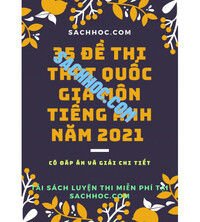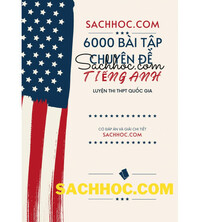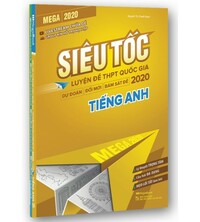Trắc nghiệm Tiếng Anh THPT Quốc gia 2017
Đề thi thử Đại học môn Tiếng Anh năm 2017 có đáp án và giải thích được chọn lọc từ các đề thi thử hay, chất lượng của các trường trong cả nước. Hi vọng với bộ đề thi này, các bạn thí sinh sẽ có thêm niềm tin vào kỳ thi TN THPT QG & ĐHCĐ sắp tới.
Đề thi thử THPT Quốc gia năm 2017 môn Tiếng Anh có đáp án + giải thích chi tiết (Đề 3)
Đề thi thử THPT Quốc gia năm 2017 môn Tiếng Anh có đáp án + giải thích chi tiết (Đề 5)
Đề thi thử THPT Quốc gia năm 2017 môn Tiếng Anh có đáp án + giải thích chi tiết (Đề 6)
Đề thi thử THPT Quốc gia năm 2017 môn Tiếng Anh có đáp án + giải thích chi tiết (Đề 7)
Mark the letter A, B, C, or D on your answer sheet to indicate the correct answer to each of the following questions.
Question 1: Last year she earned _______ her brother.
A. twice as much as B. twice more than C. twice as many as D. twice as more as
Question 2: The politician tried to arouse the crowd, but most of them were ________ to his arguments.
A. closed B. indifferent C. careless D. dead
Question 3: - Can you take the day off tomorrow?
- Well, I'll have to get _________ from my boss.
A. permission B. licence C. allowance D. permit
Question 4: I do not believe that this preposterous scheme is _____ of our serious consideration.
A. worthy B. worth C. worthwhile D. worthless
Question 5: __________ the fifth largest among the nine planets that make up our solar system.
A. The Earth being B. The Earth is C. That the Earth is D. Being the Earth
Question 6: Dr. Evans has _________ a valuable contribution to the life of the school.
A. done B. created C. caused D. made
Question 7: No matter _______, Mozart was an accomplished composer while still a child.
A. how it seems remarkable B. how remarkable it seems
C. it seems remarkable how D. how seems it remarkable
Question 8: It was difficult to guess what her ________ to the news would be.
A. feelings B. reaction C. capital D. opinion
Question 9: ________ some countries have ruined their agriculture, squandering money on uneconomic factories, the Ivory Coast has stuck to what it is good at.
A. After B. During C. When D. While
Question 10: Harry: "May I smoke?"
Kate: "________"
A. What suits you? B. You are free C. Accommodate yourself! D. Go ahead!
Question 11: Sportsmen __________ their political differences on the sports field.
A. take part B. put aside C. take place D. keep apart
Question 12: Maria: "Can I borrow your umbrella for a day?"
Ann: "___________"
A. With pleasure B. Ready C. Welcome D . Yes, I can
Question 13: When she __________ her mistake, she apologized.
A. realized B. realize C. was realizing D. has realized
Question 14: _______ is to forget all about it.
A. At best you can do B. The best thing you can do
C. What best you can do D. You can do the best
Mark the letter A, B C or D on your answer sheet to indicate the word(s) OPPOSITE in meaning to the underlined word(s) in each of the followingquestions.
Question 15: In 1864 George Pullman designed a sleeping car that eventually saw widespread use.
A. previously B. ultimately C. familiarly D. simultaneously
Question 16: Why are you being so arrogant?
A. snooty B. stupid C. humble D. cunning
Mark the letter A, B, C, or D on your answer sheet to indicate the word or phrase that is CLOSEST in meaning to the underlined part in each of the following questions.
Question 17: He was asked to account for his presence at the scene of crime.
A. complain B. exchange C. explain D. arrange
Question 18: I'll take the new job whose salary is fantastic.
A. reasonable B. acceptable C. pretty high D. wonderful
Mark the letter A, B, C, or D on your answer sheet to indicate the word that differs from the rest in the position of the main stress in each of the following questions.
Question 21: A. weather B. animal C. human D. canteen
Question 22: A. familiar B. redundant C. customary D. reluctant
Read the following passage and mark the letter A, B, C, or D on your answer sheet to indicate the correct answer to each of the questions.
Accustomed though we are to speaking of the films made before 1927 as "silent", the film has never been, in the full sense of the word, silent. From the very beginning, music was regarded as an indispensable accompaniment; when the Lumiere films were shown at the first public film exhibition in the United States in February 1896, they were accompanied by piano improvisations on popular tunes. At first, the music played bore no special relationship to the films; an accompaniment of any kind was sufficient. Within a very short time, however, the incongruity of playing lively music to a solemn film became apparent, and film pianists began to take some care in matching their pieces to the mood of the film.
As movie theaters grew in number and importance, a violinist, and perhaps a cellist, would be added to the pianist in certain cases, and in the larger movie theaters small orchestras were formed. For a number of years the selection of music for each film program rested entirely in the hands of the conductor or leader of the orchestra, and very often the principal qualification for holding such a position was not skill or taste so much as the ownership of a large personal library of musical pieces. Since the conductor seldom saw the films until the night before they were to be shown (if, indeed, the conductor was lucky enough to see them then), the musical arrangement was normally improvised in the greatest hurry.
To help meet this difficulty, film distributing companies started the practice of publishing suggestions for musical accompaniments. In 1909, for example, the Edison Company began issuing with their films such indications of mood as "pleasant', "sad", "lively". The suggestions became more explicit, and so em erged the musical cue sheet containing indications of mood, the titles of suitable pieces of music, and precise directions to show where one piece led into the next.
Certain films had music especially composed for them. The most famous of these early special scores was that composed and arranged for D. W. Griffith's film Birth of a Nation, which was released in 1915.
Question 26: The passage mainly discusses music that was ____________.
A. performed before the showing of a film B. played during silent films
C. recorded during film exhibitions D. specifically composed for certain movie theaters
Question 27: What can be inferred that the passage about the majority of films made after 1927?
A. They were truly "silent"
B. They were accompanied by symphonic orchestras
C. They incorporated the sound of the actors' voices
D. They corresponded to specific musical compositions
Question 28: It can be inferred that orchestra conductors who worked in movie theaters needed to ________.
A. be able to play many instruments B. have pleasant voices
C. be familiar with a wide variety of music D. be able to compose original music
Question 29: The word "them" in paragraph 2 refers to _________.
A. years B. hands C. pieces D. films
Question 30: According to the passage, what kind of business was the Edison Company?
A. It produced electricity B. It distributed films
C. It published musical arrangements D. It made musical instruments
Question 31: It may be inferred from the passage that the first musical cue sheets appeared around _________.
A. 1896 B. 1909 C. 1915 D. 1927
Question 32: Which of the following notations is most likely to have been included on a musical cue sheet of the early 1900's?
A. "Calm, peaceful" B. "Piano, violin"
C. "Key of C major" D. "Directed by D. W. Griffith's
Question 33: The word "scores" in paragraph 4 most likely mean ____________.
A. totals B. successes
C. groups of musicians D. musical compositions
Read the following passage and mark the letter A, B, C, or D on your answer sheet to indicate the correct word for each of the blanks.
NEIGHBOURS INFLUENCE BUYING DECISIONS
However objective we believe ourselves to be, most of us do not judge a product solely on its merits, considering quality, value and style before making a decision. (34)________, we are easily influenced by the people around us.
There is nothing wrong with this. It is probably a smarter way to make decisions than (35) ________ on only our own opinions. But it does make life hard for companies. They have long understood that groups of friends and relatives tend to buy the same products, but understanding the reasons has been tricky. It is because they are so similar with (36) _______ to how much money they make and what television ads they watch that they independently arrive at the same decision? Or do they copy one another, perhaps (37) ______ envy or perhaps because they have shared information about the products?
Research in Finland recently found overwhelming evidence that neighbours have a big influence on buying decisions. When one of a person's ten nearest neighbours bought a car, the chances that that person would buy a car of the same brand during the next week and a half (38) __________ by 86 per cent. The researchers argued that it was not just a matter of envy. Used cars seemed to attract neighbours even more than new cars. This suggested that people were not trying to keep up with their neighbours, they were keen to learn from them. Since used cars are less reliable, a recommendation of one can strongly influence a buying decision.
Question 34: A. What's more B. Instead C. Unlike D. In place
Question 35: A. basing B. trusting C. supposing D. relying
Question 36: A. connection B. regard C. relation D. concern
Question 37: A. for B. as to C. out of D. about
Question 38: A. boosted B. rose C. enlarged D. lifted
Read the following passage and mark the letter A, B, C, or D on your answer sheet to indicate the correct answer to each of the questions.
Glass is a remarkable substance made from the simplest raw materials. It can be colored or colorless, monochrome or polychrome, transparent, translucent, or opaque. It is lightweight impermeable to liquids, readily cleaned and reused, durable yet fragile, and often very beautiful. Glass can be decorated in multiple ways and its optical properties are exceptional. In all its myriad forms - as table ware, containers, in architecture and design -glass represents a major achievement in the history of technological developments.
Since the Bronze Age about 3, 000 B. C. glass has been used for making various kinds of objects. It was first made from a mixture of silica, line and an alkali such as soda or potash, and these remained the basic ingredients of glass until the development of lead glass in the seventeenth century. When heated, the mixture becomes soft and malleable and can be formed by various techniques into a vast array of shapes and sizes. The homogeneous mass thus formed by melting then cools to create glass, but in contrast to most materials formed in this way (metals, for instance), glass lacks the crystalline structure normally associated with solids, and instead retains the random molecular structure of a liquid. In effect, as molten glass cools, it progressively stiffen s until rigid, but does so without setting up a network of interlocking crystals customarily associated with that process. This is why glass shatters so easily when dealt a blow. Why glass deteriorates over time, especially when exposed to moisture, and why glassware must be slowly reheated and uniformly cooled after manufacture to release internal stresses induced by uneven cooling.
Another unusual feature of glass is the manner in which its viscosity changes as it turns from a cold substance into a hot, ductile liquid. Unlike metals that flow or freeze at specific temperatures glass progressively softens as the temperature rises, going through varying stages of malleability until it flows like a thick syrup. Each stage of malleability allows the glass to be manipulated into various forms, by different techniques, and if suddenly cooled the object retains the shape achieved at that point. Glass is thus amenable to a greater number of heatforming techniques than most other materials.
Question 39: Why does the author list the characteristics of glass in paragraph 1?
A. To demonstrate how glass evolved B. To show the versatility of glass
C. To explain glassmaking technology D. To explain the purpose of each component of glass
Question 40: What does the author imply about the raw materials used to make glass?
A. They were the same for centuries B. They are liquid
C. They are transparent D. They are very heavy







